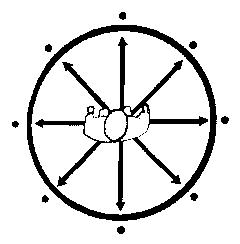
|
Angles Of Evasion |
|
by Grand Master James S. Benko, Ph.D. |
|
The angles of evasion correspond with the eight avenues
of approach in that they are, in one sense, the same angles
in relation to your position. Just as an attack may come
from angles which would normally off-balance you, so you may
use the eight avenues of approach in a reverse manner. Thus
they become the "eight" angles of evasion. The theory of the
angles of evasion is fundamental in all aspects of life.
If someone yelled "look out!", and as you looked up you
saw something falling toward you, you would, without knowing
it, use one of the angles of evasion to avoid the falling
object. When you are walking down a narrow hallway and
another person is walking toward you, you use an angle of
evasion by stepping to your right or left and turning your
body slightly to one side as you walk past each other.
The angles of evasion and avenues of approach are also
used in all forms of combat. It is a theory which cannot be
ignored no matter what walk of life you come from. Whether
moving out of the way of a line drive or side-stepping a
bayonet thrust on the battlefield, you are using angles of
evasion in relation to an avenue of approach. To properly
understand and utilize the avenues of approach and angles of
evasion, you must be able to determine the DIRECTION OF
FORCE.
|

|
|
|
Angles of evasion permit you to avoid direct contact with an opponent's attack. But they do much more than this. You are able to lead your opponent into a technique of neutralization by drawing him into your sphere of defense. For example; as an opponent steps toward you in an attempt to grab you, you step away with your left foot as your right hand comes over the top of his extended arm. As the opponent sees you attempting to step beyond his reach, he lengthens his reach by stepping further toward you and extending his arm as far as possible in an attempt to grab you. He has now gone beyond his "range of stability". At this point you have drawn him into your defensive sphere, placed him in a position of physical instability, and strategically positioned yourself for the implementation of a technique of neutralization. As you seize the wrist of the opponent's extended arm, you step with your right foot to your rear while rotating the opponent's arm to your right and toward the ground. You may, at this time, immobilize the opponent with one, or a combination of, joint manipulation techniques (kwan jyel sul). The angles of evasion are the basis for footwork and efficient mobility. Your movements along these "angles" may be linear (angular or straight-lined), circular, or a combination of these movements. If an opponent steps toward you and punches at your head, you could evade the attack by moving your right foot to your front right, while at the same time striking the opponent with your left hand. His blow continues past you as he continues to move directly into the path of your counter-movement. This is an example of "angular' movement along the angles of evasion. Using the same attack for demonstration purposes, this time move your right foot in a circular motion to your front right until you are in a sitting stance (horse-riding stance), facing the opponent as he steps toward your original position with his straight punch. As you step into your stance, deflect his punch with your left hand as you strike the opponent with your right hand. This is an example of the implementation of "circular" movement along the angles of evasion. The eight angles of evasion are the key to evading an opponent's attack. To evade the attack you simply move along one of the eight angles along which no hostile force is directed toward you. You may use these "evasions" to position yourself to counterattack the opponent, or to move out of his range of attack and completely avoid any type of confrontation whatsoever. A detailed study and understanding is crucial to understanding the theories of defensive action |
"Theories of Defensive Action" and the "Angles Of Evasion".
 |
All rights reserved.